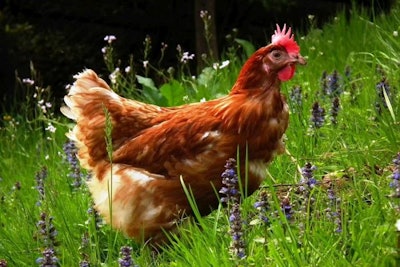
Silvopasture is an agroforestry practice that integrates livestock, forage production and low-density forestry in a way that is mutually beneficial. Advantages of a properly managed silvopasture operation are improved livestock and pasture performance, restored ecological functions, such as enhanced soil protection, and increased long-term income due to the simultaneous production of trees and grazing or foraging animals.
Jason Fischbach, a food and energy wood crops specialist with the University of Wisconsin Extension and owner and operator of Wild Hollow Farm, presented his model for raising poultry on silvopasture at the 2016 Midwest Organics and Sustainable Education Service (MOSES) Organic Farming Conference, February 25-27, in La Crosse, Wisconsin. Wild Hollow Farm, which is part of a partnership of five poultry producers near Ashland, Wisconsin, produces pastured poultry, including broilers and turkeys, lumber and hazelnuts.
Silvopasture has been profitable for Wild Hollow Farm and its partnership, Pasture Perfect Poultry. Fischbach uses a mobile day-range system that allows the birds to roam free on pasture during the day and stay safe in an enclosure at night. The pasture has been designed in a way that allows the system and the birds to move freely, minimizing labor and labor costs.
Silvopasture provides multiple benefits
Raising pastured poultry comes with many challenges, both financially and with the birds. “It’s a decent return, but it’s also risky,” said Fischbach. “Things can go wrong in a hurry. If you have a mortality loss, if a skunk or an owl gets in there and wipes you out, your returns for that batch aren’t going to be profitable. The other big problem is from your opportunity cost. All that cash is being spent up front before you sell those chickens. As you know, in the livestock business, it’s a difficult business because of that.”
Silvopasture, which mimics the workings of natural ecosystems for farm purposes, can mitigate these risks. The trees are managed for high-value saw logs, nuts or fruits, and, at the same time, provide shade and shelter for the poultry, reducing stress. The birds provide manure for the soil, improving soil fertility. The length of the forage season and forage quality also improves with partially shaded pastures, increasing yield and lowering feed costs.
Tree cover is managed at 25 to 45 percent cover for warm season grasses and 40 to 60 percent for cool season grasses, according to the U.S. Department of Agriculture (USDA) National Agroforestry Center (NAC). More than 60 percent stifles forage growth, and less than 25 percent results in livestock congregating around the few trees and an increased risk of aerial predators for poultry. Silvopasture trees can be arranged in uniform block plantings, clusters or in rows. Evenly distributed trees optimize the growing space and light for both the trees and forages.
Fischbach suggests planting hybrid poplar in the pasture, because it grows quickly and you get a marketable product faster.
“The reason I think that poultry is such a great fit for woody crops is that with woody crops you always have a pre-production phase, and the fact that you have manure in those fields doesn’t matter. You can use poultry to make money while those woody plants mature,” said Fischbach.















